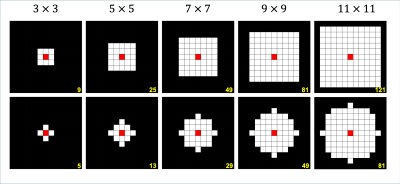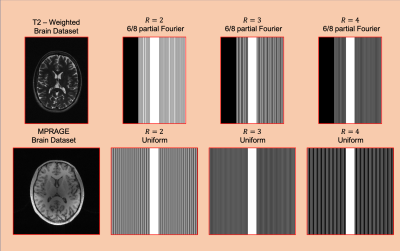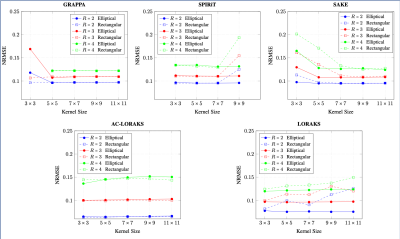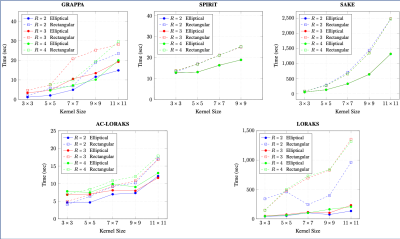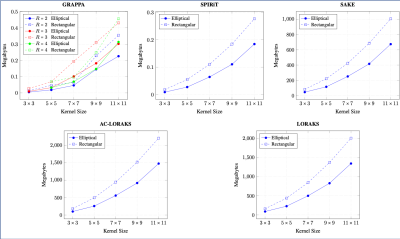2407
Improving the Performance of Accelerated Image Reconstruction in K-Space: The Importance of Kernel Shape1Electrical Engineering, University of Southern California, Los Angeles, CA, United States
Synopsis
A variety of popular k-space reconstruction methods (e.g., GRAPPA, SPIRiT, SAKE, LORAKS) assume that missing k-space data can be interpolated by convolving the k-space data with appropriate filters. In most of these methods, the kernel shape is usually chosen to be rectangular. However, when these filters are interpreted in the spatial domain, the use of rectangular kernels implies that the filters will have anisotropic resolution. In this work, we investigate the use of elliptical kernels that have more isotropic resolution. Results demonstrate that elliptical kernels have better reconstruction performance, lower computational complexity, and lower memory usage than rectangular kernels.
Introduction
Several MRI reconstruction methods (e.g., GRAPPA1, SPIRiT2, SMASH3, PARS4, SAKE5, LORAKS6) are based on the principle that a missing k-space sample can be predicted as a linear combination of neighboring samples, which can be implemented using shift-invariant filtering with appropriate kernels. Most of these methods use a rectangular kernel shape, i.e., a k-space sample will be considered as a “neighbor” if it lies within a rectangular region around the sample to be interpolated, as illustrated in Fig. 1. While some researchers used ellipsoidal kernels instead4,6, we are not aware of previous comparisons of these alternatives. In this work, we analyze how kernel shape influences image reconstruction performance. Results suggest that ellipsoidal kernels are generally better than conventional rectangular neighborhoods. This observation is potentially important for improving existing popular image reconstruction methods and may be especially relevant to emerging k-space reconstruction methods based on convolutional neural networks7-9.Theory
Choosing the number of neighbors to use for k-space interpolation is a classical trade-off. If too few neighbors are chosen, then the model may not have enough representational capabilities to accurately interpolate a missing sample. Conversely, if too many neighbors are chosen, then the model will have a large number of degrees of freedom, and estimating the kernel weights may be prone to overfitting and sensitive to noise. Larger kernels are also generally associated with higher computational complexity. As a result, it is important to choose a kernel that balances these factors appropriately.
The conventional rectangular kernel is very easy to implement, which may explain its popularity. However, based on the observation that filtering with these k-space kernels can be interpreted as pointwise multiplication in the spatial domain6,10, it can be recognized that rectangular k-space coverage is associated with anisotropic spatial resolution11. Notably, removing the corners of a rectangular k-space region (i.e., an ellipsoid) will not compromise the base spatial resolution, will lead to isotropic resolution, and will reduce the number of k-space locations by more than 20%11. All of these are expected to be beneficial for k-space reconstruction.
Methods
We tested the difference between rectangular and ellipsoidal methods on five different methods that utilize k-space neighborhoods: GRAPPA1, SPIRiT2, SAKE5, AC-LORAKS12 (using the S-matrix), and LORAKS6 (using the S-matrix). In each case, we considered several different kernel sizes (as depicted in Fig. 1). Results were investigated for two different retrospectively-undersampled cases. The first case was based on a 12-channel T2-weighted brain dataset with full samples on a 256x187 Cartesian grid. The second case was based on a 4-channel T1-weighted brain dataset with full samples on a 258x256 Cartesian grid. In both cases, we assumed that the central 24 lines of k-space were fully sampled as an autocalibration (ACS) region, and considered three different acceleration factors (R=2,3,4) for retrospectively undersampling the remainder of k-space. We considered 6/8 partial Fourier sampling for the T2-weighted dataset, and conventional k-space coverage for the MPRAGE dataset. The datasets and sampling patterns are shown in Fig. 2.Results
Due to space constraints, we only show the results of the T2-weighted dataset, although note that the results from the MPRAGE data were very consistent with the T2-weighted results. Fig. 3 shows a comparison of normalized mean-squared reconstruction error (NRMSE) as a function of kernel size and kernel shape. As can be seen, there is frequently not much difference between rectangular and elliptical kernel shapes from an NRMSE perspective (as expected, since both approaches have the same base spatial filter resolution), although elliptical kernels generally perform better when there is a difference. In addition, Figs. 4 and 5 demonstrate that elliptical neighborhoods generally have a substantial advantage in both computational complexity and memory usage compared to rectangular neighborhoods.Discussion and Conclusions
We performed what we believe is the first detailed analysis of how kernel shape influences image reconstruction speed and quality for popular k-space interpolation methods. Our results suggest that the conventional choice to use rectangular kernels is generally suboptimal compared to using elliptical kernels. This observation holds consistently across a wide range of reconstruction methods and for two different datasets. While this observation may be surprising because elliptical kernels are not used in popular implementations, it is consistent with our theoretical expectations.
We expect that our results may lead to substantial improvements in computational complexity and efficiency for a variety of existing k-space reconstruction methods. In addition, we believe that our observations may be especially pertinent to emerging reconstruction methods7-9 that train convolutional neural networks for k-space reconstruction, but which so far have universally relied on rectangular kernel shapes.
Acknowledgements
This work was supported in part by research grants NSF CCF-1350563, NIH R21-EB022951, and NIH R01 MH116173.References
[1] Griswold MA, Jakob PM, Heidemann RM, Nittka M, Jellus V, Wang J, Kiefer B, Haase A. "Generalized autocalibrating partially parallel acquisitions (GRAPPA)." Magnetic Resonance in Medicine 47:1202-1210, 2002.
[2] Lustig M, Pauly JM. "SPIRiT: iterative self‐consistent parallel imaging reconstruction from arbitrary k‐space." Magnetic Resonance in Medicine 64:457-471, 2010.
[3] Sodickson DK, Manning WJ. "Simultaneous acquisition of spatial harmonics (SMASH): ultra-fast imaging with radiofrequency coil arrays." Magnetic Resonance in Medicine 38:591– 603, 1997.
[4] Yeh EN, McKenzie CA, Ohliger MA, Sodickson DK. "Parallel magnetic resonance imaging with adaptive radius in k‐space (PARS): Constrained image reconstruction using k‐space locality in radiofrequency coil encoded data." Magnetic Resonance in Medicine 53:1383-92, 2005.
[5] Shin PJ, Larson PE, Ohliger MA, Elad M, Pauly JM, Vigneron DB, Lustig M. "Calibrationless parallel imaging reconstruction based on structured low‐rank matrix completion." Magnetic Resonance in Medicine 72:959-970, 2014.
[6] Haldar JP. "Low-rank modeling of local-space neighborhoods (LORAKS) for constrained MRI." IEEE Transactions on Medical Imaging 33:668-681, 2014.
[7] Akçakaya M, Moeller S, Weingärtner S, Uğurbil K. "Scan‐specific robust artificial‐neural‐networks for k‐space interpolation (RAKI) reconstruction: Database‐free deep learning for fast imaging." Magnetic Resonance in Medicine 00:1-15, 2018.
[8] Cheng JY, Mardani M, Alley MT, Pauly JM, Vasanawala SS. "DeepSPIRiT: Generalized Parallel Imaging using Deep Convolutional Neural Networks." Proc. ISMRM 2018, p0570.
[9] Han Y, Ye JC. "k-Space Deep Learning for Accelerated MRI." arXiv preprint arXiv:1805.03779, 2018.
[10] Murphy M, Alley M, Demmel J, Keutzer K, Vasanawala S, Lustig M. "Fast$\ell_1$-SPIRiT Compressed Sensing Parallel Imaging MRI: Scalable Parallel Implementation and Clinically Feasible Runtime." IEEE Transactions on Medical Imaging 31:1250-1262, 2012.
[11] Bernstein MA, Sean BF, Riederer SJ. "Effect of windowing and zero‐filled reconstruction of MRI data on spatial resolution and acquisition strategy." Journal of Magnetic Resonance Imaging 14:270-280, 2001.
[12] Haldar JP. "Autocalibrated LORAKS for fast constrained MRI reconstruction." Proc. IEEE International Symposium on Biomedical Imaging 2015, pp. 910-913.
Figures
